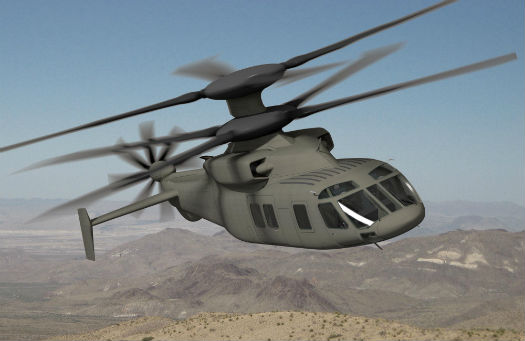
Boeing-Sikorsky plans to produce three variants from the X2, including the JMR technology demonstrator. Boeing-Sikorsky Graphic
Directors of the Boeing-Sikorsky team that is building a technology demonstrator (TD) for the U.S. Army’s Joint Multi-Role (JMR) program said the companies plan to develop three different sizes of the X2/S-97 Raider to present the military with a family of options for the Future Vertical Lift (FVL) effort.
Doug Shidler, director of the JMR TD for Sikorsky Aircraft, and Pat Donnelly, who holds the same position for Boeing, provided an update on the program during an Oct. 14 press conference at the Association of the U.S. Army (AUSA) conference in Washington, DC. The Boeing-Sikorsky team is competing with a group led by Bell Helicopter with its V-280 Valor tiltrotor, which will feature mission systems from Lockheed Martin and engines from GE.
With the JMR tech demonstrator scheduled to fly in 2017, the Boeing-Sikorsky team intends to design an 11,000-pound version of its 6,000-pound X2/S-97 Raider known as the SB>1 Defiant. Then, with the FVL prototype in the post-2025 range, the manufacturers will create a supersized 30,000-pound iteration.
“What’s important about these three elements — the JMR tech demonstrator, FVL and the X2 tech demonstrator — is that they’re in three different weight classes, which is important to demonstrate the scalability of this configuration and architecture,” said Shidler, adding that there will be many steps throughout the JMR and FVL process involving a number of demonstrations.
The JMR demonstrator will incorporate the technology from the X2, which Sikorsky began developing in 2005, followed by the first flight of a demonstration aircraft in 2008 and passing the 250-knot milestone in September 2010. The following year, Sikorsky took the X2 out of service after 23 flights with the start of the S-97 offshoot military variant. Earlier this year, Boeing and Sikorsky announced plans to team on JMR and Future Vertical Lift. The U.S. Army Aviation Technology Directorate chose two teams in August 2014 to enter phase one of the JMR program: Defiant and Valor. Sikorsky rolled out the S-97 Raider prototype on Oct. 2 during an event in West Palm Beach, Fla.

Boeing-Sikorsky is competing with the Bell V-280 Valor third-generation tiltrotor, shown here at AUSA 2014. Andrew Parker Photo
The timeframe for phase one calls for JMR technology demonstrations to occur in 2017. According to Shidler, the U.S. Army will begin the process of conducting an analysis of alternatives (AOA) in about a year, followed by the official kick-off of the program in 2017. At that point, Boeing-Sikorsky will “inform them of what our platform can do, its capabilities in terms of mission execution, and so forth,” he said. Phase one tests the vehicle and fundamental performance attributes, while phase two will focus on mission system architecture, including sensors, navigation, radios and survivability equipment. Initial operating capacity (IOC) is projected for 2034.
In addition to speed, a lift offset coaxial rotor system, retractable landing gear, low-speed maneuverability, decreased downwash, and hot-and-high performance to 6,000 feet/95 degrees F (1,829 meters/35 degrees C) are among the advantages of the JMR configuration, according to Shidler. He noted that the SB>1 Defiant is designed with a maritime application in mind for future Naval applications, including folding blades.
Donnelly pointed out the capabilities of the pusher prop in the back of the aircraft, including acting as a brake to slow down the aircraft using reverse thrusters. “You can back up,” he added, noting that the aircraft can “hover at 20 degrees nose down, 20 degrees nose up with that prop.”
The cabin will carry up to 12 combat troops. “Large troops,” Donnelly explained, noting that the Defiant cabin will be “roughly 50 percent larger than a Black Hawk cabin also designed to carry 12 troops.”
For the technology demonstrator, Boeing-Sikorsky plans to employ the Honeywell T-55, the engine serving the Boeing CH-47 Chinook. Donnelly remarked that while the T-55 provides “more power than we’ll need” for the JMR demonstrator, the team “wanted an engine that had adequate power. It had to be off-the-shelf with a digital flight engine control system.”
“People talk about speed,” added Shidler, “but as you execute a mission, simply speaking there are two parts of it — one, the horizontal part of the mission, or speed. Equally important is the vertical side, such as inserting or extracting troops and getting into that tight landing zone. This platform will enable us to get there fast, but also conduct those missions in a confined landing area like a conventional helicopter.”

Sikorsky displayed the S-97 Raider during AUSA 2014. Andrew Parker Photo









